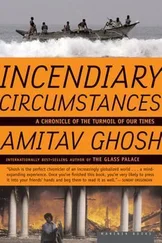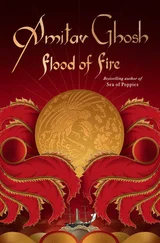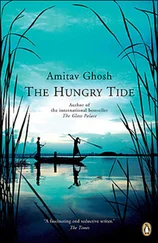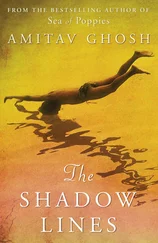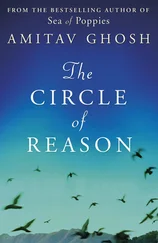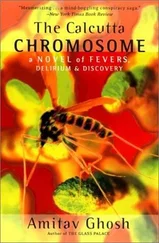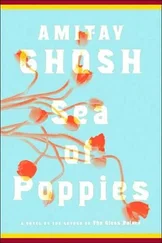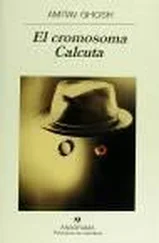‘You have no business to be angry, Rajkumar. In his place you would be no different, perhaps worse. What amazes me is that more of them are not like this one.’
‘Why, Sayagyi?’
‘Think of the kind of life they lead here, these young Europeans. They have at best two or three years in the jungle before malaria or dengue fever weaken them to the point where they cannot afford to be far from doctors and hospitals. The company knows this very well; it knows that within a few years these men will be prematurely aged, old at twenty-one; and that they will have to be posted off to city offices. It is only when they are freshly arrived, seventeen or eighteen, that they can lead this life, and during those few years the company must derive such profit from them as it can. So they send them from camp to camp for months on end with scarcely a break in between. Look at this one: I am told he has already had a bad bout of dengue fever. That man is not much older than you, Rajkumar — maybe eighteen or nineteen — and here he is, sick and alone, thousands of miles from home, surrounded by people the likes of whom he has never known, deep inside a forest. And look at him: there he is, reading his book, with not a trace of fear on his face.’
‘You are far from home too, Sayagyi,’ said Rajkumar. ‘And so am I.’
‘But we are not so far as he is. And left to ourselves none of us would have been here, harvesting the bounty of this forest. Look at the oo-sis in this camp; look at the hsin-ouq, lying on his mat, dazed with opium; look at the false pride they have in their skill as trainers of elephants. They think, because their fathers and their families have all worked with elephants, that no one knows their animals as they do. Yet until the Europeans came none of them had ever thought of using elephants for the purposes of logging. Their elephants were used only in pagodas and palaces, for wars and ceremonies. It was the Europeans who saw that tame elephants could be made to work for human profit. It was they who invented everything we see around us in this logging camp. This entire way of life is their creation. It was they who thought of these methods of girdling trees, these ways of moving logs with elephants, this system of floating them downriver. Even such details as the structure and placement of these huts, the plan of the tai, the use of bamboo thatch and rattan — it was not the oo-sis with their hoary wisdom who thought of these things. All of this came from the minds of men like this one sitting in this tai — this boy who is not much older than you.’
The merchant thrust a finger at the silhouetted figure in the tai. ‘You see that man, Rajkumar?’ he said. ‘That is someone you can learn from. To bend the work of nature to your will; to make the trees of the earth useful to human beings — what could be more admirable, more exciting than this? That is what I would say to any boy who has his life before him.’
Rajkumar could tell that Saya John was thinking not of him, his luga-lei, but of Matthew, his absent son, and the realisation brought a sudden and startling pang of grief. But the pain lasted only an instant and when it had faded Rajkumar felt himself to be very much the stronger, better prepared. He was here, after all, in this camp — while Matthew was far away in Singapore.

In Ratnagiri there were many who believed that King Thebaw was always the first to know when the sea had claimed a victim. He spent hours on his balcony every day, gazing out to sea with his gold-rimmed glasses. Fishermen had learnt to recognise the distinctive twin flashes of the King’s binoculars. Returning to the bay, of an evening, they would look up in the direction of the hilltop balcony, as though for reassurance. Nothing happened in Ratnagiri, people said, but the King was the first to know of it.
Yet, the King himself was never seen after that first day when he rode up from the harbour with his family. The royal coaches were a familiar sight around town, with their teams of dappled horses and their moustachioed coachman. But the King never went out in them, or if he did, it was impossible to tell. The Royal Family had two gaari s — one an open trap and the other a brougham with curtained windows. There were rumours that the King was sometimes hidden inside the brougham, but no one could be sure because of the heavy velvet curtains.
The Princesses, on the other hand, were seen around town three or four times every year, driving down to the Mandvi jetty or to the Bhagavati temple, or to the houses of those British officials whom they were permitted to visit. The townsfolk knew them all by sight — the First, Second, Third and Fourth Princesses (the last was born in Ratnagiri, in the second year of the King’s exile).
In their early years in India, the Princesses usually dressed in Burmese clothes — aingyis and htameins. But as the years passed their garments changed. One day, no one quite remembered when, they appeared in saris — not expensive or sumptuous saris, but the simple green and red cottons of the district. They began to wear their hair braided and oiled like Ratnagiri schoolgirls; they learned to speak Marathi and Hindustani as fluently as any of the townsfolk — it was only with their parents that they now spoke Burmese. They were pleasant-looking girls and there was something about them that was very direct and unaffected. When they drove through the streets they neither averted their gaze nor looked away. There was a hunger in their eyes, a longing, as though they yearned to know what it was like to walk through the Jhinjhinaka bazaar, to dawdle at the shops and bargain for saris. They sat alert and upright, taking everything in, and occasionally asking questions of the coachman: Whose sari shop is that? What sort of mangoes are those on that tree? What kind of fish is that hanging in that stall over there?
Mohan Sawant, the coachman, was a local boy, from an impoverished hamlet down by the river. He had dozens of relatives in town, working as rickshaw-pullers, coolies and tonga-wallahs: everyone knew him.
When he came down to the bazaar, people would seek him out: ‘Give the Second Princess these mangoes. They’re alphonsos from our garden.’ ‘Give the little girl a handful of this dried kokum. I saw her asking you about it.’
The Princesses’ eyes touched everyone they lit upon. They were children: what had they done that they should live like this? Why should they be prevented from visiting local families; from forming friendships with Marathi children of good education? Why should they grow to womanhood never knowing any company other than that of their servants?
Once or twice a year the Queen would ride out with her daughters, her face a white mask, stern and unmoving, her lips stained a deep, deathly mauve by her cheroots. People would crowd into the streets to look at her as she rode by, but she never seemed to notice anyone or anything, sitting as straight as a rod, her face stern and unmoving.
And then there was Miss Dolly, with her long, black hair and her chiselled face, as beautiful as a fairytale princess. Over the years, all the others who had accompanied the Royal Family to Ratnagiri had drifted slowly away — the maidservants and royal relatives and household officials. Only Miss Dolly stayed.

The King knew what people said of him in Ratnagiri, and if he was alarmed by the powers attributed to him, he was also amused and not a little flattered. In small ways he tried to do his duty by the role that had been thrust on him. Sometimes women would stand on their roofs, holding high their newborn children in the hope of attracting the imagined benedictions of his gaze. He would keep his glasses trained on these credulous mothers for several minutes at a time. It seemed a very small thing to ask for and why should he not grant those things that were in his power to give?
Читать дальше
Конец ознакомительного отрывка
Купить книгу



